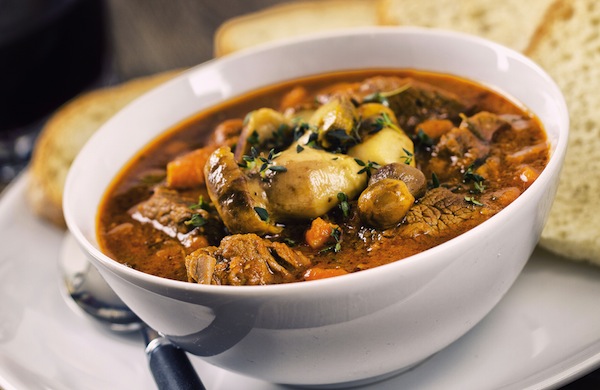
As many know in Saint Paul, restaurants aren’t necessarily the best place to find their favorite dish. Mention the word booya to someone from the St. Paul-East Metro region, and the wave of nostalgia is palpable as they remember neighborhood gatherings, playing games with their cousins and classmates, the grownups dancing, their uncles ladling fragrant stew into bowls and freezer containers.
Mention the word booya to anyone outside the area, even other Minnesotans, and you’ll likely get a confused high-five. The dish is so regional that many Minnesotans who aren’t from the St. Paul area have never heard of it.
You Won’t Find Booya at a Restaurant
As mentioned, you probably won’t find booya served at Minneapolis restaurants—unless, that is, there’s a special event. Also known as booyah, bouja, or other phonetic iterations, its roots, like those of many regional dishes, are murky. According to the most told tale, a schoolteacher organized a community picnic. To feed everyone, he gathered ingredients from neighborhood families for a traditional Belgian soup he called bouillon.
The word booya also refers to the gathering at which the booya is served. Usually a community event in the fall, such as a church or school fundraiser, some booyas have been running for decades.
But What Is Booya?
At its most basic, it’s a thick soup or stew ostensibly of Belgian origins, per that schoolteacher. Its broth is made from pig bones. It usually includes pork, beef, and chicken, sometimes oxtail as well. Chopped veggies and beans are added.
The seasoning blend that each crew uses is heavily guarded. Longtime booya chefs cook from top-secret recipes that have been passed down from chef to chef, some for decades. Fans are known to wait ardently all year for their favorite booya, toting to-go containers so they can freeze some at home.
Never Too Many Chefs
Even the crafting of the booya is a community endeavor. Neighbors donate ingredients, such as vegetables and meat, lend the cooking team tools and utensils, and most of all give their time to the dish’s creation.
A good booya can take up to three days to make—some even go for a week. As it’s meant to feed many mouths, it requires prep time for pounds of vegetables and meats and hours upon hours of stirring and simmering and stirring some more. It takes at least two people to pull it off; some booya chefs put together teams of sous chefs and simmer attendants to help with the work.
And then there are the pots. Booya is cooked and served in enormous batches, enough to feed hundreds, and therefore requires huge kettles to make sure it’s cooked properly. Some municipalities own their own set; the Highland neighborhood’s kettles are more than 50 years old and collectively simmer over 350 gallons of the stuff. Another crew’s pots are so big, they stir their booya with canoe paddles.
Where to Get It
In the St. Paul area
Here are some traditional booyas that serve up a stew many residents say might be better than what’s served at the best restaurants in Minneapolis:
- Obb’s Sports Bar & Grill holds a booya in the fall plus one for New Year’s Eve.
- Even if you miss the yearly fall booya at the Church of St. Agnes, you can pick up some frozen at the church kitchen on Sundays.
- For a hearty breakfast, hit up Maplewood’s St. Jerome Catholic Church, where the ladles hit the pots at 7 a.m. for the fall festival.
- You have to act fast to get some of the Roseville Fire Department’s fall booya—they start serving at 11 a.m. and usually run out by 1 p.m.
Out of State
As booyas are also popular in Wisconsin (and the Upper Peninsula of Michigan), you can find the dish at these restaurants:
- Motor Bar, the café at the Harley-Davidson Museum in Milwaukee, serves a bowl of booya stew made with chicken and beef.
- Green Bay’s Kroll’s West Restaurant serves slow-cooked booya in a diner-style setting.
- Find chicken booya crafted by comfort-food specialists The Rite Place, also in Green Bay.








